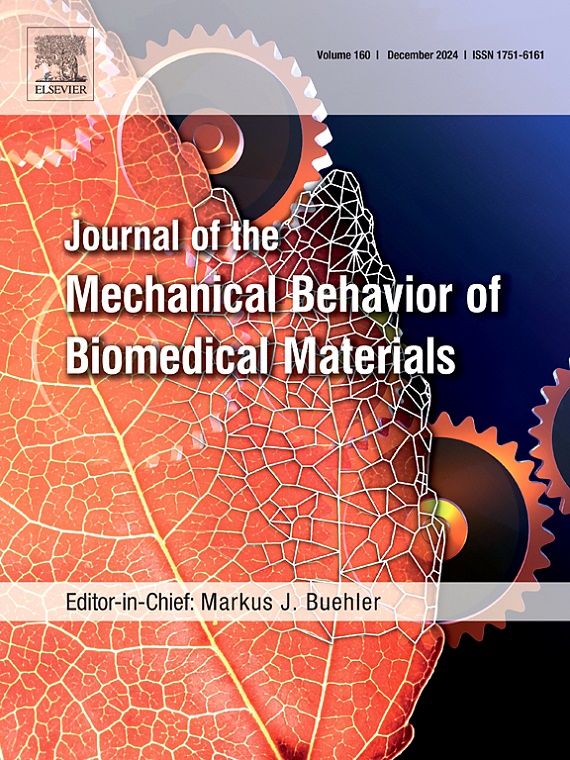Mechanical and adhesive properties of additively manufactured dental tray materials with variable sustainability profiles
IF 3.3
2区 医学
Q2 ENGINEERING, BIOMEDICAL
Journal of the Mechanical Behavior of Biomedical Materials
Pub Date : 2025-06-27
DOI:10.1016/j.jmbbm.2025.107115
引用次数: 0
Abstract
Objective
To assess the mechanical and adhesive properties of additively manufactured (AM) materials with variable sustainability and recyclability as alternatives to traditional light-cured acrylic resin for dental custom trays.
Materials and method
Four different AM materials; a photopolymer resin tray material printed with DLP and three FDM printed polylactic acid (PLA), recycled PLA and Polyethylene Terephthalate Glycol (PETG) and a conventional light-cure acrylic resin (LC PMMA) as a control were used to construct dumbbell (tensile testing), rectangular (flexural testing) to verify suitability for custom trays (n=10/group). To evaluate bond strength, specimens were manufactured at 0, 45 and 90° printing orientation (n=10/group). Surface roughness was evaluated with confocal scanning microscopy. The three mechanical tests were completed in a universal testing machine (Instron) according to ISO 527-2 and ISO 20795-1. Results were statistically analysed with PRISM (Version 10) Software using one-way ANOVA and Kruskal-Wallis tests, with statistical significance set at p < 0.05. Confocal analysis and SEM analysis were conducted for quantitative and qualitative surface analysis.
Results
For tensile and flexural strength, PLA (Recycled) and PETG showed no statistically significant difference (p > 0.05) from LC PMMA. AM materials yielded a higher bond strength than the LC PMMA material. Print orientation was found to affect the bond strength of some materials with varying surface roughness as contributing factors.
Conclusion
LC PMMA, PLA (Recycled), and PETG have the greatest flexural and tensile strengths. PLA (Recycled) and PETG were the highest performing AM options with regard to flexural and tensile strength for custom trays. All AM materials showed a significantly higher bond strength compared to LC PMMA. To maximise the bond strength, PLA (Recycled) should be printed at an angle of 0°, and PETG at 0 or 90°. Dental practitioners should consider the varying degrees of recyclability of materials, in addition to their mechanical properties.
具有可变可持续性轮廓的增材制造牙托材料的机械和粘合性能
目的评价具有可变可持续性和可回收性的增材制造(AM)材料替代传统光固化丙烯酸树脂用于牙科定制托盘的力学和粘接性能。四种不同的增材制造材料;用DLP和三种FDM打印的聚乳酸(PLA),回收PLA和聚对苯二甲酸乙二醇酯(PETG)以及传统光固化丙烯酸树脂(LC PMMA)作为对照,构建哑铃(拉伸测试),矩形(弯曲测试),以验证定制托盘的适用性(n=10/组)。为了评估粘接强度,在0°、45°和90°的打印方向(n=10/组)下制作标本。用共聚焦扫描显微镜评估表面粗糙度。根据ISO 527-2和ISO 20795-1,在通用试验机(Instron)中完成三项机械测试。采用PRISM (Version 10)软件进行统计学分析,采用单因素方差分析和Kruskal-Wallis检验,p <为统计学显著性;0.05. 采用共聚焦分析和扫描电镜分析进行表面定量和定性分析。结果PLA(再生)与PETG在拉伸和弯曲强度方面差异无统计学意义(p >;0.05)从LC PMMA。增材制造材料产生了比LC PMMA材料更高的结合强度。发现印刷方向会影响一些表面粗糙度不同的材料的结合强度。结论lc PMMA、PLA(再生)和PETG具有最大的抗弯和抗拉强度。PLA(可回收)和PETG在定制托盘的弯曲和拉伸强度方面是性能最高的增材制造选择。与LC PMMA相比,所有AM材料的结合强度都显着提高。为了最大限度地提高粘合强度,PLA(可回收)应以0°的角度打印,PETG应以0或90°的角度打印。牙科医生除了考虑材料的机械性能外,还应考虑材料的不同程度的可回收性。
本文章由计算机程序翻译,如有差异,请以英文原文为准。
求助全文
约1分钟内获得全文
求助全文
来源期刊

Journal of the Mechanical Behavior of Biomedical Materials
工程技术-材料科学:生物材料
CiteScore
7.20
自引率
7.70%
发文量
505
审稿时长
46 days
期刊介绍:
The Journal of the Mechanical Behavior of Biomedical Materials is concerned with the mechanical deformation, damage and failure under applied forces, of biological material (at the tissue, cellular and molecular levels) and of biomaterials, i.e. those materials which are designed to mimic or replace biological materials.
The primary focus of the journal is the synthesis of materials science, biology, and medical and dental science. Reports of fundamental scientific investigations are welcome, as are articles concerned with the practical application of materials in medical devices. Both experimental and theoretical work is of interest; theoretical papers will normally include comparison of predictions with experimental data, though we recognize that this may not always be appropriate. The journal also publishes technical notes concerned with emerging experimental or theoretical techniques, letters to the editor and, by invitation, review articles and papers describing existing techniques for the benefit of an interdisciplinary readership.
 求助内容:
求助内容: 应助结果提醒方式:
应助结果提醒方式:


